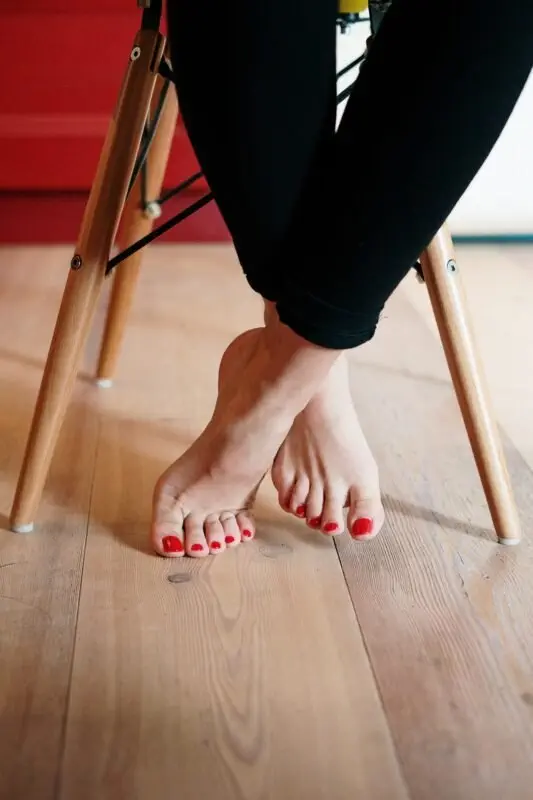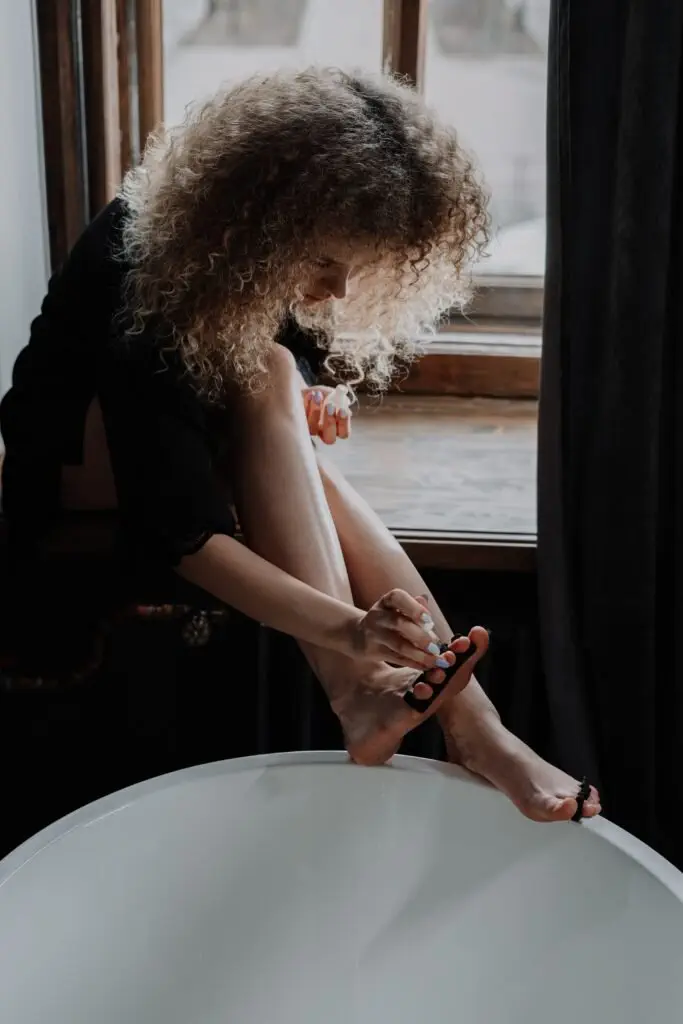Ingrown nail, we meet again. What is it about you that makes me feel the need to pull out my file and get rid of all traces of your existence? I can’t help but wonder if there’s something wrong with me because one day, suddenly getting a good pedicure isn’t enough for these little suckers anymore. Nothing else has worked to ease the pain so far this month (and not until next Friday). Is this all sound familiar to you? Luckily there are ways to prevent this condition from happening to your feet. Let’s see how much you know about ingrown nails.
My experience with ingrown toenails
Because I read a fair bit about ingrown toenail posts to realize most of the posts are copypasta from one source to another. I highly doubt writers have an ingrown or even touch their own feet, let alone write posts about it. Surprisingly, people follow to a T regarding the post is full of false information about the problem itself.
Sometimes I think my ingrowing toenails are the bane of my existence. Ever since I was little, cutting them has been a routine for me, and it’s never gone wrong before until it was. It started as any other situation with an over-curious child, but once curiosity met ignorance, things got ugly fast. Lol.
One minute you’re happily clipping away, then suddenly: BAM! You thought everything would be okay; you let it slide for a while. Guess what? You’ve inflicted more pain on yourself than ever expected, landed in some severe trouble, too, when auntie needs to do emergency surgery because everything else failed miserably along the way.
She’s living in France now and is the head priestess of a Buddhist pagoda. Back then, she was just an ordinary nurse. When I was younger, I was a sick kid, and I got to see everyone from doctors, nurses, therapists technicians. I never wanted to return to a hospital or revisit any of them. I developed this semi hatred of them because of, well, needles. Lol.
My aunt tried giving me some anesthetic before poking at my wounds, but my body was tense. I broke the needle halfway in my butt. Lol. She had to take time to pull that “better half” out of the way. There was no way I could relax when I saw those big ass needles. Lol. I cried out, “No! No needles!” but her sharp tools under the fire managed nonetheless.
I remembered the feeling of my mother’s hands on me as I writhed in agony while all around me wrestled. My father and uncle held down my arms and legs still for the operation so that they could hold back any horrifying screams from escaping past the hand towel stuffed into my mouth.
Meanwhile, auntie pulled out chunks of an infected ingrown toenail, along with pus, with her tools. That’s not all she tried to do. She got the sharp needles and pressed out as much pus from my wound as possible. Man, I still remember that raw pain even though I have tattoos that almost cover up my sleeves.
I learned about how much worse it could have been if she hadn’t acted quickly enough. Ever since then, I look at that ingrown toenail pain differently, like they’re serious stuff and not something you can toy and pluck out however you want.
The blood finally seeped through gauze pads, but at least those worried eyes looked back with relief. Okay, it was no more pulling out ingrown toenails for me. Lol.
And look what I am doing for a living now. Life is trolling me for sure. Haha.
What are ingrown nails, and what causes them?
If you think ingrown nails only happen to people who bite their nails, think again because I doubt anyone is flexible enough to bite their toenails. Lol.
A nail becomes ingrown after it curves into the skin instead of growing outwards like normal. It happens because we often trim toenails too short or at a funny angle. And we wear ill-fitting shoes without socks or chances of being inherited from one or both parents.
The force above pushes the top part of your toes against other toes or against your shoes. It will cause massive friction and pressure on the big toes. So they grow downwards rather than straight ahead. As a result, the sides of your nail curl down and dig in.
You will often find ingrown in your toes than you would on the hands. It is mainly because some footwear almost always covers your feet. In comparison, the palms of our hands can go without being touched for long periods during the day.
The use of our feet frequently during sports can lead to the formation of ingrown nails. Older people with thicker toenails are also at risk. This risk is higher if you have diabetes, heart disease, tobacco usage, and other condition that cause poor circulation near the toenail region.
If not fitted properly, your shoes can lead to painful roots developing in your feet. That’s not all. The trapped moisture and bacteria can get under your skin and grow on your nail edges, causing an ingrown toenail.
Pedicures can result in an ingrown toenail with a nail technician who is too aggressively cutting back nails.

Why do your ingrown toenails hurt or bleed so much?
The short version is summarized in one word – pressure. The extended version is that because the ingrown curves into the skin, you’re basically “walking on the nail,” and it causes too much pressure without giving your muscles or nerves to rest.
Your body’s natural reaction will try and protect itself from injury by causing blood vessels in the area to constrict or close off completely. This action causes even more pressure around those affected areas, resulting in le pain.
That explains why you’d see a red bump or blister-like swelling on top of an ingrown nail or flaky skins surrounding it. That’s when you know you have ingrown toenails, and if the ingrown grow out long enough, it starts to hurt real bad.
Ingrown toenail doesn’t bleed on their own unless infected by a cut due to the lack of blood flow and nerve sensitivity. But imagine when you walk, there’s dirt scrape up against the ingrown, and the friction is like shoving salts on your open wounds. It hurts and bleeds.
Usually, you wouldn’t feel any discomfort until you start using your feet or put pressure on them. The muscles contract around them, causing inflammation.
When you remove the ingrown nail, it can cause blood vessels in and underlying nail bed to rupture, resulting in bleeding. So it’s natural for an ingrown nail to bleed if it gets pulled out violently.
Though, I rarely bleed a client, even if their infected nail is severe. There’s an art in it too. I most likely find that nail techs aren’t careful enough. Their clippers accidentally nick the delicate skin around the ingrown nails, or they pull the ingrown toenails out too hard, causing a semi-bloodbath. Lol.
Common misconceptions about ingrown toenail
To put it simply: if you clip your toenails too short, then there is an increased risk for them breaking or peeling off prematurely from being so thin at their tips. It encourages the skin at the sides of the nail to fold over.
What’s behind those broken parts is usually sensitive skin or tissues, meaning these fragile areas could theoretically be prone to cracking and splitting even further down the line over time, worsening the symptoms. These nails may not have enough surface area to stimulate growth, or the shape will change because there is less support underneath.
When that happens, the nail bed will become exposed, making it difficult to grow long, healthy fingernails/toenails in the future.
Like you can cut them short, but not too short if it makes sense. It is essential to leave enough of “the white” part of the nail. It ensures that there aren’t any soft tissues (light pink) that might trigger an ingrown toenail or other problems.
To provide medical advice, orthopaedic surgeons are better than foot and ankle surgeons (podiatrists)? I’d say it depend on who’s answering? Lol.
Podiatrists are like foot fetish guys. They spend their entity studying anything related to the foot, ankle, and lower leg. Their full residency training is also on those subjects.
Therefore they can offer more treatment methods than orthopaedic surgeons, who primarily are surgeons to start with. So orthopaedic surgeons’ approach will focus more on surgeries, while some podiatrists don’t do surgery or are not trained to do so.
Don’t try to be smart and use a wedge to gently lift your nail, or use waxed dental floss under the nail edge. They say ingrown toenail treatment may include placing cotton underneath your nail. But it’s wrong because cotton pads provide a breeding ground for bacteria and won’t do much in terms of guiding your nail growth.
It’ll only cause an ingrown toenail infection. If you want something that will protect your toes from tight shoes, I recommend toe caps since these provide an extra layer against any material scraping off skin cells.

If you ever believe in some “cult” that says don’t remove your infected ingrown toenails, then here’s a quick rundown of the dangers. If they’re not cut off soon enough (as with my 24-year old customer), it can lead to decaying skin.
Not to mention that if an ingrown toenail causes a break on the surface tissue, bacteria can enter, making it even more uncomfortable.
When the said customer came in, at that point, it was a black hole full of blood and pus. It looks disgusting, and it smells too. I still remember the mental image.
We only cleaned up a little, but there wasn’t much more that could be done tbh. We asked the customer to see a doctor who has serious stuff like morphine and other drugs for an operation because the affected toe was awful.
Like seriously, man, why don’t you ever take care of yourself? I cannot even imagine being able to walk with such intense pain myself.
To remove or not to remove ingrown nails?
So yeah, painful ingrown toenails that stay unreachable for much longer can cause serious consequences. Other possible infections include foot ulcers, bone infections, decaying tissues, etc.
Suppose you have diabetes or vascular problems or often get numb on your toes. In that case, it is essential to prevent ingrown toenails as soon as possible by using home remedies, or seeing a professional, whether an experienced technician or a podiatrist.
An ingrown toenail can heal appropriately on its own. In severe cases, the healthcare provider will present a surgical treatment. It’s called a nail avulsion. The doctor numbs the region and removes the problematic nail(s). Some say surgery is needed, either partial or total removal of an ingrown toenail because they’ll grow out better.
Do you know what I think? Your body is an organic work of art, with some parts need serious work to grow *cough cough*. Except that, once you rip off your toenails violently, the nerves and surrounding tissue are permanently damaged.
It can take months and years to grow back, and it is more likely to misshapen when it grows back. Sometimes, it won’t grow back at all. While it can be tempting to have an ingrown toenail removed so as not to experience any more discomfort, but think about not having toenails, okay?
Your nails are there to protect your body, even though it’s not a smart iPhone; it doesn’t work with you, sadly. But once you have them surgically removed, it’ll be even more painful because you’d have nothing to shield you.
I have saved up to $5k-$6k on each customer who wanted the ingrown nail removed. Give me 5-8 months, and I’ll cut them properly for 1/10 of the price!
As a result, your toe heals quickly, and it’ll grow out better depending on your body reaction. I’ll make those pesky little thingies look and feel nice again or get your money back. Or not.

How to treat an ingrown nail
Now that we know, an ingrown toenail is caused by toenail curves into your skin. It can cause discomfort, inflammation, and also infection if left untreated for too long. There are a few home remedies to treat ingrown toenails. There isn’t a way to “fix” it unless you have it removed, but there are ways to prevent it from happening.
- The most basic of them is by filing your nail away from any skin. This way, you will not have a sharp edge that can cause an infection and produce pain when it’s accidentally touched.
- Don’t wear shoes that are not fitting you properly or have an uncomfortable insole – this will cause your nail to grow into itself instead of outwards as it should. Luckily there’s a quick fix: grab some cuticle cream. Apply it around the base of your nail bed on both sides, where you would typically see blisters forming. It helps with swelling and provides a temporary barrier until you switch out your shoes, or do something about it.

- Wear open-toed shoes, comfortable shoes, and just better-fitting shoes in general, or leave adequate room near the toe area. So air circulates freely. Otherwise, it can cause some nerve damage too if the shoes are too tight and your feet can’t feel it. If you work in harsh environments, steel-toed shoes would be recommended.
- Keep your foot dry. Otherwise, you’re going to marinate your feet in the same trapped moisture and bacteria from last wear, and it’s no bueno. I swear I sometimes see customers wearing those worn shoes that they must have kept since their high school sweetheart. Brothers and sisters, let them go. Lol. Suppose your shoes turn black and start to accumulate gunk that you can’t wash off; you know it’s time to throw them away.
- Keep the area clean with warm water and saline solution. To manage the symptoms, you can soak your feet in warm water for 15-20 minutes. Do this three to four times a day at its worst, and 3-4 times/month for maintenance at home, especially if you don’t go to a salon.
It’ll make your toe feel less tender and can help with swelling. Or just a simple warm bath will tend to reduce symptoms within a couple of days. If you feel fancy, you can grab some Epsom salts at Wally World instead of shaking your salt bottle vigorously into your bathtub.
The one I’d recommend is Epsom salt+, meaning it’s Epsom salts with minerals and essential oils. It just smells better tbh. Lol. But honestly, some of the plus ingredients help to relieve the aches. If you want, you can also bring some to your nail shop, especially if you don’t do any of the premium pedicures.
- Consider taking pain relievers such as acetaminophen or ibuprofen, antibiotic cream, or antibiotic ointment to ease soreness, inflammation, tenderness, and swelling. Or you can head to your doc for some oral antibiotics.
- Avoid wearing tight socks. As they don’t allow feet room to expand when we walk, creating pressure on our toes. And don’t forget to wash your socks too!
- Trim your toenails straight, even if you’re not. It will reduce the chance of an ingrown toenail get pushed deeper, making matters worse. And, of course, don’t cut them too short. The toenail grows out properly will give a doctor/technician more room to wiggle.
- Better yet, don’t attempt to cut an ingrown toenail yourself. Avoid cutting into the corners or cutting the V shape if you don’t know what you’re doing. If the ingrown toenail gets cut at a weird angle, it can be worsened.
- Avoid too much physical activity if you’re hurt, so you won’t repeatedly put stress on your toes.
- Make sure to go to an experienced technician if you need your ingrown toenail taken care of.
One customer took me almost three months to get her painful ingrown toenails in the big toes. The nails gripped deeply, so she was in a terrible agony. I could only weaken the grip by the sides of the nail little by little each time we met up.
Anytime this woman comes around, chances she has another appointment with the feet doc soon. And idk what the heck that foot doc is doing. Lol. Shouldn’t he be doing a better job than me? Shouldn’t he be doing anything at all?
It’s been said that knowledge is power, and I couldn’t agree more. Without enough knowledge, we risk seeking help from the wrong people who may end up exacerbating the problem. And trust me, this doesn’t just apply to foot doctors, even your nail tech could be the culprit! So stay informed and don’t be afraid to ask questions. After all, a little bit of knowledge can go a long way in ensuring your well-being.

Conclusion
So there you have it; you’re now armed with the knowledge to prevent an ingrown toenail problem on your own. But wait, don’t hesitate to see me too because I do it better, baby.
There is no “one size fits all” solution to preventing this issue, and it’ll come back because your nails always grow out. But if you know what causes ingrown toenails and how they work, it should be easier to take care of your feet and stop the situation from getting out of control.
In the end, though, I think the best way to prevent an ingrown toenail is just by practicing good hygiene.
You can stop by any day, and I’ll give you a good plucking. I mean a good pedi.
Ciao.












